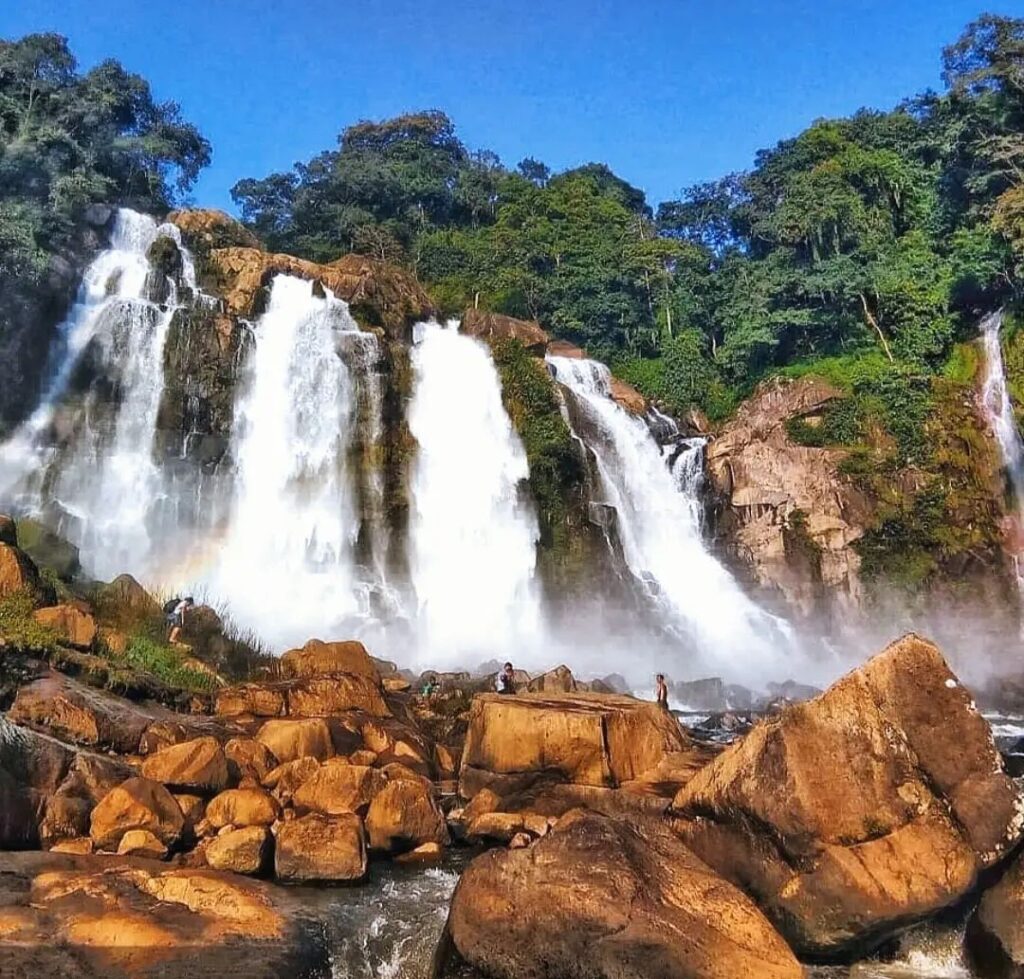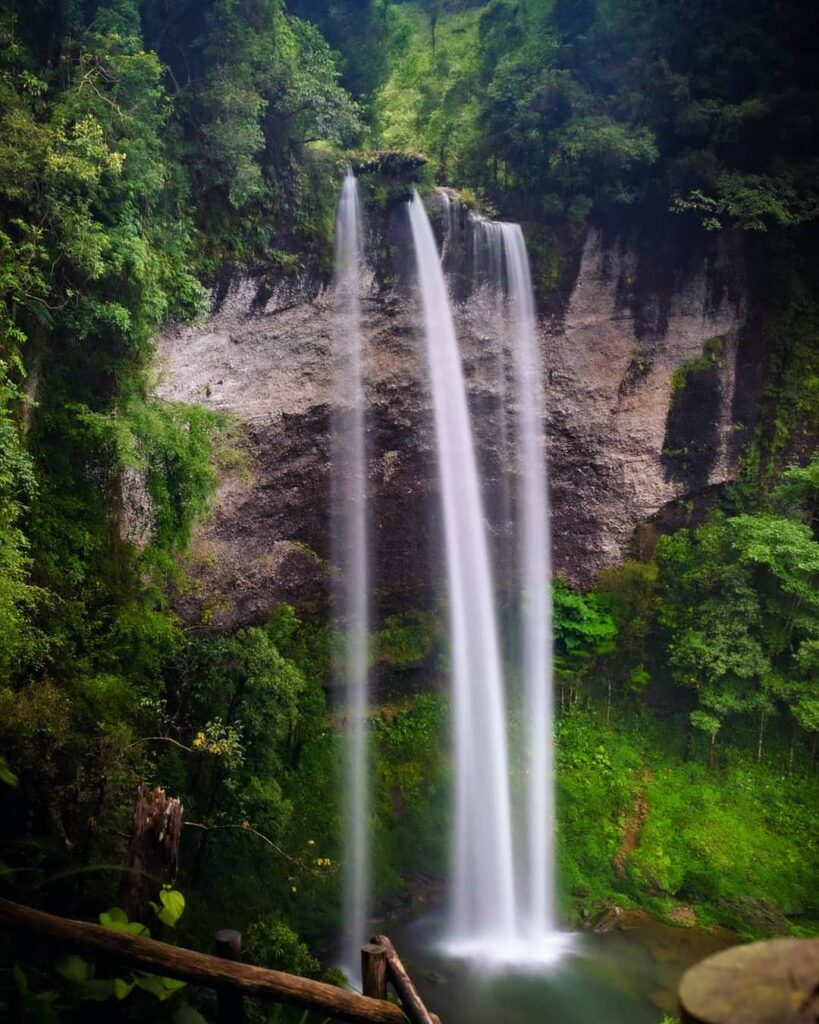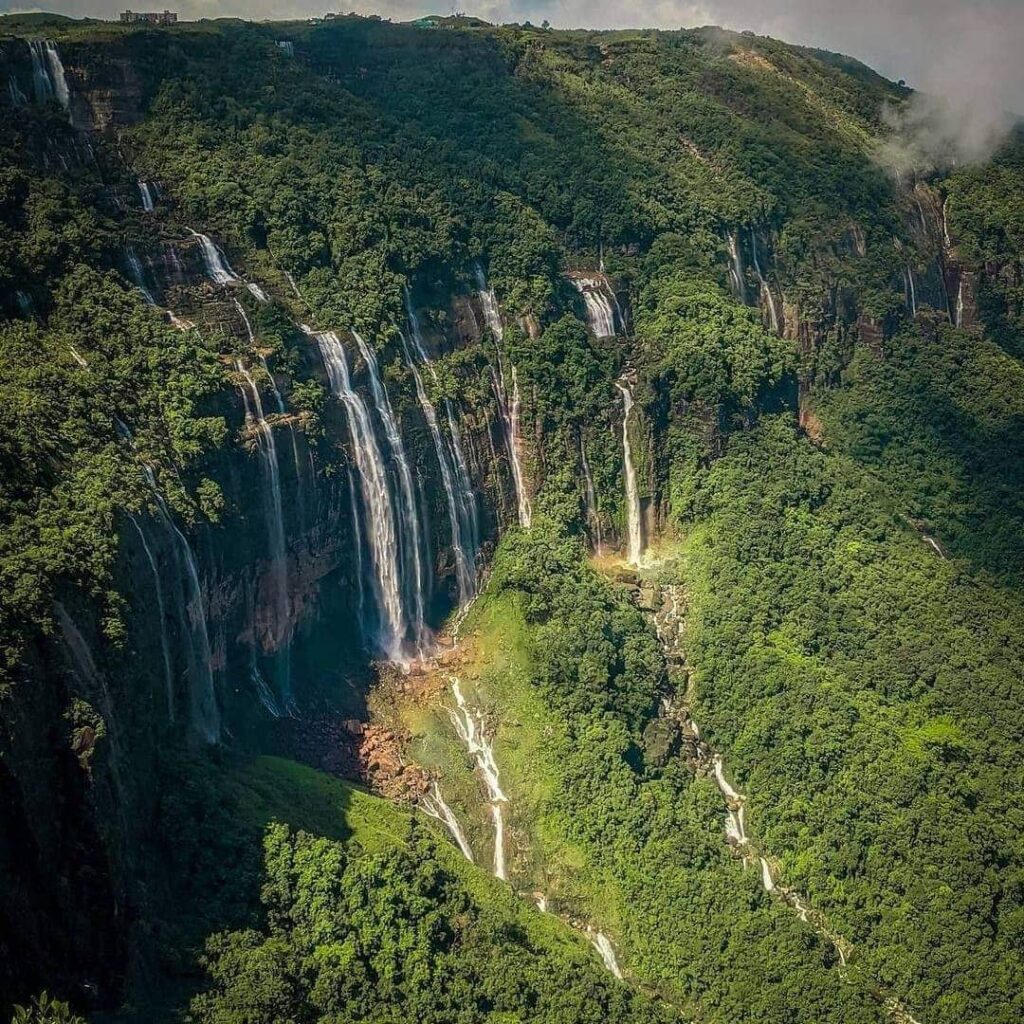Introduction
Meghalaya, often referred to as the “Meghalaya: Abode of Clouds,” is a breathtakingly beautiful state located in the northeastern region of India. Known for its lush landscapes, vibrant culture, and unique weather patterns, Meghalaya offers a unique travel experience, especially during the monsoon season in July. This guide explores everything you need to know about visiting Meghalaya in July, from its mesmerizing waterfalls and lush green hills to its rich cultural heritage and adventurous activities.

The Monsoon Magic of July
Weather and Climate
July marks the peak of the monsoon season in Meghalaya, transforming the state into a verdant paradise. The average temperature ranges between 15°C to 25°C, creating a cool and comfortable climate perfect for exploration. The heavy rainfall during this month breathes life into the region’s flora, making the landscapes even more enchanting.
The Beauty of Waterfalls
Meghalaya is renowned for its numerous waterfalls, which are at their most magnificent in July. The increased water flow during the monsoon season makes these waterfalls a sight to behold. Some of the must-visit waterfalls include:
- Nohkalikai Falls: Known as the tallest plunge waterfall in India, Nohkalikai Falls is a spectacular sight during July. The cascading water, surrounded by lush greenery, creates a mesmerizing view.
- Seven Sisters Falls: Also known as Nohsngithiang Falls, this waterfall is a collection of seven segmented falls, offering a stunning spectacle of nature’s power and beauty.
- Dainthlen Falls: Located near Sohra (Cherrapunjee), Dainthlen Falls is not only beautiful but also steeped in local legends, adding a mystical charm to its natural allure.
Lush Green Landscapes
The incessant rains in July rejuvenate Meghalaya’s landscapes, turning the entire state into a lush green haven. The hills, valleys, and forests are carpeted with vibrant greenery, making it a perfect time for nature lovers to visit. The rolling hills of the Khasi, Jaintia, and Garo regions are particularly captivating during this time.
Top Attractions in Meghalaya in July
Cherrapunjee (Sohra)
Often known as one of the wettest places on Earth, Cherrapunjee is a must-visit destination in July. The town is famous for its living root bridges, limestone caves, and stunning viewpoints. Key attractions include:
- Living Root Bridges: These unique bridges, made from the roots of rubber trees, are a testament to the ingenuity of the Khasi people. The double-decker root bridge in Nongriat village is particularly famous.
- Mawsmai Cave: An accessible limestone cave with impressive formations, Mawsmai Cave offers an exciting caving experience.
- Eco Park: Offering panoramic views of the hills and valleys, Eco Park is a great spot for a leisurely walk and some stunning photography.

Shillong
The capital city of Meghalaya, Shillong, is often called the “Scotland of the East” due to its picturesque landscapes and colonial architecture. In July, Shillong’s natural beauty is enhanced by the monsoon rains. Key attractions include:
- Ward’s Lake: A serene lake surrounded by well-manicured gardens, perfect for a relaxing boat ride.
- Elephant Falls: Named after a rock resembling an elephant, this three-tiered waterfall is a popular tourist spot.
- Shillong Peak: The highest point in the region, offering panoramic views of the city and the surrounding hills.
Mawlynnong
Known as the “Cleanest Village in Asia,” Mawlynnong is a charming village that epitomizes cleanliness and natural beauty. In July, the village is surrounded by lush greenery, making it even more appealing. Key attractions include:
- Sky Walk: A bamboo structure that offers a bird’s eye view of the village and the Bangladesh plains.
- Balancing Rock: A natural wonder where a huge rock is balanced on a smaller one, defying gravity.
Dawki and Umngot River
Dawki is a small town near the India-Bangladesh border, famous for the crystal-clear waters of the Umngot River. In July, the river is fed by the monsoon rains, making it even more pristine. Activities include:
- Boating: A boat ride on the Umngot River is a surreal experience, as the water is so clear that boats appear to be floating in the air.
- Border Visit: The Dawki-Tamabil border is a popular spot for tourists to witness the friendly exchanges between India and Bangladesh.
Nokrek National Park
Located in the Garo Hills, Nokrek National Park is a biodiversity hotspot and a UNESCO Biosphere Reserve. July is an excellent time to explore the park’s rich flora and fauna. Key highlights include:
- Red Panda Habitat: The park is home to the endangered red panda, although spotting one is a rare treat.
- Hoolock Gibbons: The only ape species found in India, Hoolock gibbons can be seen swinging through the trees.
- Bird Watching: The park is a paradise for bird watchers, with numerous species of birds inhabiting the area.
Cultural Experiences in Meghalaya
Festivals and Traditions
Meghalaya is rich in cultural heritage, with various tribes celebrating their unique traditions and festivals. While July is not a major festival month, you can still experience the vibrant culture through:
- Local Cuisine: Savor traditional Khasi, Jaintia, and Garo dishes such as Jadoh (rice with meat), Nakham Bitchi (spicy fish soup), and Pukhlein (sweet rice bread).
- Traditional Music and Dance: Witness traditional music and dance performances that reflect the rich cultural tapestry of Meghalaya.
Handicrafts and Souvenirs
Meghalaya is known for its skilled artisans who produce beautiful handicrafts. Some popular items to look out for include:
- Bamboo and Cane Products: From baskets to furniture, the craftsmanship of bamboo and cane products in Meghalaya is exceptional.
- Handwoven Textiles: The local handwoven shawls and stoles make for perfect souvenirs.
- Organic Spices and Tea: Meghalaya’s organic produce, including spices and tea, are great gifts to take back home.

Adventure Activities
Trekking and Hiking
Meghalaya’s rugged terrain offers numerous trekking and hiking opportunities. In July, the trails are lush and scenic, though they can be challenging due to the rains. Some popular treks include:
- Double-Decker Root Bridge Trek: This trek to Nongriat village takes you through dense forests and involves crossing several root bridges.
- David Scott Trail: A historical trail named after a British officer, offering stunning views and a glimpse into the region’s history.
- Laitlum Canyons: A trek to Laitlum Canyons provides panoramic views of the surrounding hills and valleys.
Caving
Meghalaya is home to some of the longest and deepest caves in India. July, with its flowing streams and underground rivers, adds to the excitement of caving. Some notable caves include:
- Siju Cave: Known for its impressive limestone formations and bat colonies.
- Mawsmai Cave: An accessible cave with stunning stalactites and stalagmites.
- Liat Prah Cave: One of the longest caves in India, ideal for experienced cavers.
Water Sports
The numerous rivers and lakes in Meghalaya offer various water sports activities, especially during the monsoon season. Some popular options include:
- Kayaking: The rivers in Meghalaya are perfect for kayaking, with both calm and challenging sections.
- Fishing: Enjoy fishing in the clear rivers and lakes, a relaxing way to spend a day amidst nature.
- River Rafting: The monsoon-swollen rivers provide excellent opportunities for river rafting, with the Barapani Lake being a popular spot.
Practical Information
Getting There
- By Air: The nearest airport to Meghalaya is in Guwahati, Assam. From there, you can take a taxi or bus to Shillong, which is approximately 100 kilometers away.
- By Train: The closest railway station is also in Guwahati. From the station, you can hire a taxi or take a bus to Meghalaya.
- By Road: Meghalaya is well-connected by road. Regular bus services are available from Guwahati to various parts of the state.
Accommodation
Meghalaya offers a range of accommodation options to suit different budgets:
- Luxury Hotels: For those looking for a luxurious stay, there are several high-end hotels and resorts in Shillong and other major towns.
- Mid-Range Hotels: There are numerous mid-range hotels and guesthouses that offer comfortable stays at reasonable prices.
- Homestays: For a more authentic experience, consider staying in a local homestay. This allows you to experience the local culture and hospitality firsthand.
Travel Tips
- Carry Rain Gear: July is the peak of the monsoon season, so be prepared for heavy rains. Carry waterproof clothing, sturdy shoes, and umbrellas.
- Stay Informed: Keep an eye on weather forecasts and local news to stay updated on weather conditions and road accessibility.
- Respect Local Customs: Meghalaya is home to diverse cultures and traditions. Be respectful of local customs and traditions during your visit.
- Stay Hydrated and Carry Snacks: While exploring the natural beauty of Meghalaya, make sure to stay hydrated and carry snacks, especially if you’re going on long treks or hikes.
Conclusion
Visiting Meghalaya in July offers a unique and unforgettable experience. The state’s lush green landscapes, cascading waterfalls, rich cultural heritage, and adventurous activities make it a perfect destination for nature lovers and thrill-seekers alike. Despite the challenges posed by the monsoon rains, the rewards are immense, with stunning scenery and warm local hospitality waiting to be discovered. So pack your bags, prepare for an adventure, and immerse yourself in the monsoon magic of Meghalaya.
FAQ:Meghalaya
1. Why should I visit Meghalaya in July?
2. What is the weather like in Meghalaya in July?
How do I get to Meghalaya?
What are the accommodation options in Meghalaya?
What are the must-visit attractions in Meghalaya in July?
1) Nohkalikai Falls
2) Seven Sisters Falls
3) Living Root Bridges in Cherrapunjee
4) Mawlynnong (Cleanest Village in Asia)
5) Dawki and the Umngot River
6) Nokrek National Park
I am passionate about helping businesses grow their online presence and achieve measurable results. Let’s connect and discuss how I can help you reach your digital marketing goals!




